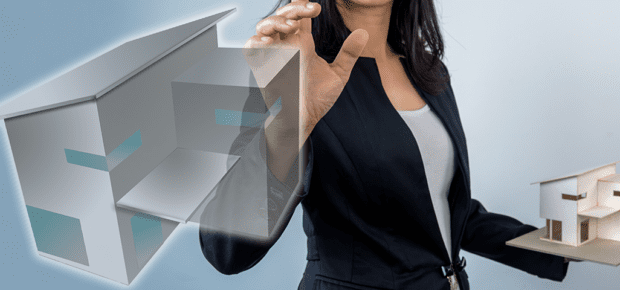February 5, 2018
When using immersive virtual reality systems, people tend to walk between points as they would in the real world, despite the fact that they don’t necessarily need to. A new study published by IEEE from the University of Portsmouth in the U.K. investigates this phenomenon.
Using an open-plan room, the researchers allowed participants to walk naturally between assigned points in the physical space. Textures were added to the room to simulate grass, rocks, water and ice. Digital versions were added to a VR replica of the room. Users were then instructed to walk between the same points virtually.
Ultimately, the researchers found little statistical difference between the way users moved around in the real-world scenario and the replica, other than how fast they moved (they were slower in the VR replica).
Said the researchers, “The behaviour of participants who choose to adhere to the visual stimuli can be traced to two main motivations: routine behaviour learnt in past real life situations, and fear of adverse consequences.” So, “Participants who decided to walk around the pond, even though that would have increased the length of their route, did so because they were unsure of what would happen if they walked over it.”
Despite participants saying they often didn’t feel “present” in the virtual environment, confusing what was supposed to be ice with sand, “the fear of the potential negative consequences was strong enough to overcome their awareness of the illusion.”
This work has implications that can help improve the believability of the VR experience. Since aesthetics are sufficient to shape the paths users take in a VR environment, designers can employ barriers like hallways, windows and cliffs to minimize the number of situations that bring into question the authenticity of the experience.
As headsets and graphics engines improve, the VR simulation will continue to get better. In the meantime, aside from avoiding questionable situations, contextual clues like showing cracks in ice when a user steps on it can help maintain a coherent experience.
Further implications might also lie in the use of physical objects in the VR room. The combination of immaterial and tangible objects reinforced the illusion that they might all really be tangible, meaning that a few well-thought-out props could go a long way.
Stay tuned for more Transmitter insights on VR/AR, and see the full study on IEEE Xplore.
For More Information
Altering User Movement Behaviour in Virtual Environments
In immersive Virtual Reality systems, users tend to move in a Virtual Environment as they would in an analogous physical environment.





 Meaningful Momentum or Running in Place?
Meaningful Momentum or Running in Place? AI Through Our Ages
AI Through Our Ages Liquid Infrastructure: Our Planet's Most Precious Resource
Liquid Infrastructure: Our Planet's Most Precious Resource The Impact of Technology in 2025
The Impact of Technology in 2025 Quantum and AI: Safeguards or Threats to Cybersecurity?
Quantum and AI: Safeguards or Threats to Cybersecurity? Why AI Can't Live Without Us
Why AI Can't Live Without Us Bits, Bytes, Buildings and Bridges: Digital-Driven Infrastructure
Bits, Bytes, Buildings and Bridges: Digital-Driven Infrastructure Impact of Technology in 2024
Impact of Technology in 2024 Emerging AI Cybersecurity Challenges and Solutions
Emerging AI Cybersecurity Challenges and Solutions The Skies are Unlimited
The Skies are Unlimited Smart Cities 2030: How Tech is Reshaping Urbanscapes
Smart Cities 2030: How Tech is Reshaping Urbanscapes Impact of Technology 2023
Impact of Technology 2023 Cybersecurity for Life-Changing Innovations
Cybersecurity for Life-Changing Innovations Smarter Wearables Healthier Life
Smarter Wearables Healthier Life Infrastructure In Motion
Infrastructure In Motion The Impact of Tech in 2022 and Beyond
The Impact of Tech in 2022 and Beyond Cybersecurity, Technology and Protecting Our World
Cybersecurity, Technology and Protecting Our World How Technology Helps us Understand Our Health and Wellness
How Technology Helps us Understand Our Health and Wellness The Resilience of Humanity
The Resilience of Humanity Harnessing and Sustaining our Natural Resources
Harnessing and Sustaining our Natural Resources Creating Healthy Spaces Through Technology
Creating Healthy Spaces Through Technology Exceptional Infrastructure Challenges, Technology and Humanity
Exceptional Infrastructure Challenges, Technology and Humanity The Global Impact of IEEE's 802 Standards
The Global Impact of IEEE's 802 Standards Scenes of our Cyber Lives: The Security Threats and Technology Solutions Protecting Us
Scenes of our Cyber Lives: The Security Threats and Technology Solutions Protecting Us How Millennial Parents are Embracing Health and Wellness Technologies for Their Generation Alpha Kids
How Millennial Parents are Embracing Health and Wellness Technologies for Their Generation Alpha Kids Space Exploration, Technology and Our Lives
Space Exploration, Technology and Our Lives Global Innovation and the Environment
Global Innovation and the Environment How Technology, Privacy and Security are Changing Each Other (And Us)
How Technology, Privacy and Security are Changing Each Other (And Us) Find us in booth 31506, LVCC South Hall 3 and experience the Technology Moon Walk
Find us in booth 31506, LVCC South Hall 3 and experience the Technology Moon Walk Virtual and Mixed Reality
Virtual and Mixed Reality How Robots are Improving our Health
How Robots are Improving our Health IEEE Experts and the Robots They are Teaching
IEEE Experts and the Robots They are Teaching See how millennial parents around the world see AI impacting the lives of their tech-infused offspring
See how millennial parents around the world see AI impacting the lives of their tech-infused offspring Take the journey from farm to table and learn how IoT will help us reach the rising demand for food production
Take the journey from farm to table and learn how IoT will help us reach the rising demand for food production Watch technical experts discuss the latest cyber threats
Watch technical experts discuss the latest cyber threats Explore how researchers, teachers, explorers, healthcare and medical professionals use immersive technologies
Explore how researchers, teachers, explorers, healthcare and medical professionals use immersive technologies Follow the timeline to see how Generation AI will be impacted by technology
Follow the timeline to see how Generation AI will be impacted by technology Learn how your IoT data can be used by experiencing a day in a connected life
Learn how your IoT data can be used by experiencing a day in a connected life Listen to technical experts discuss the biggest security threats today
Listen to technical experts discuss the biggest security threats today See how tech has influenced and evolved with the Games
See how tech has influenced and evolved with the Games Enter our virtual home to explore the IoT (Internet of Things) technologies
Enter our virtual home to explore the IoT (Internet of Things) technologies Explore an interactive map showcasing exciting innovations in robotics
Explore an interactive map showcasing exciting innovations in robotics Interactively explore A.I. in recent Hollywood movies
Interactively explore A.I. in recent Hollywood movies Get immersed in technologies that will improve patients' lives
Get immersed in technologies that will improve patients' lives